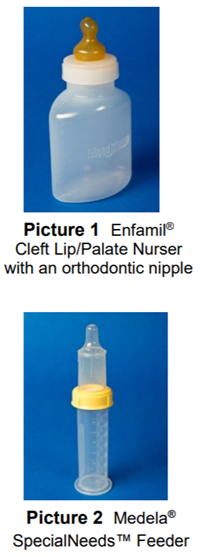Cleft Palate: Feeding Your Baby

The palate, more commonly referred to as the roof of the mouth, separates the mouth from the nose. The palate is important for feeding and speaking. A cleft is an opening or split in the palate. This cleft can make feeding hard for your baby. Most babies with a cleft of the palate are not able to use standard bottles or solely breast feed because they cannot create the suction needed to draw the milk out of the nipple. Special bottles and nipples are available to help infants with cleft palate feed and grow. These bottles may be used with formula or breast milk.
Supplies for Feeding Your Baby
Treating Cleft Palate
The Cleft Lip and Palate Center expertly cares for children with cleft palate.
Several types of bottles and nipples are available to help you feed your baby. You may need to try more than one feeding system before finding the best one for you and your baby. Our feeding team will work with you and your family to make sure your baby is feeding well and gaining weight.
Examples of Feeding Systems
Assisted Delivery Systems

- Enfamil® Cleft Lip/Palate Nurser: This bottle is soft and squeezable and comes with a long, stiff nipple. It can also be used with any standard sized nipple, like an orthodontic nipple. To feed your baby, gently squeeze the bottle using a pulsing rhythm while your baby is sucking to help provide the milk (Picture 1).
- Medela® SpecialNeeds™ Feeder (formerly known as the Haberman Feeder™): The flow rate can be adjusted depending on which line is pointing toward the baby’s nose. This nipple has a one-way flow valve to allow the milk to enter your baby’s mouth when the nipple is squeezed. (Picture 2).
Infant paced systems
- Pigeon™ Nipple/Bottle: This Nipple fits on any standard bottle. It has a one-way flow valve that is inserted into the nipple. The special nipple has a soft side and a hard side (Picture 3). The hard side faces up and the soft side sits on the baby’s tongue. There is a notch (air vent) on the nipple that faces toward the baby’s nose during feeding. The baby compresses on the nipple during feeding to draw the formula or breast milk into their mouth.
- Dr. Brown’s Specialty Feeding System®: This feeding system also has a one-way flow valve that is placed into the nipple to help your baby feed. This valve is very important for feeding. It cannot be found in the bottles available at stores, so it must be purchased online. Please discuss this with our feeding team. The one-way flow valve allows your baby to self-pace by compressing on the nipple. The valve can be used with any level nipple, but you must watch your baby carefully during feeding to make sure the breast milk or formula is not flowing too fast.
How to Feed Your Baby
Here are some tips for feeding:
- Prepare the formula or breast milk for the bottle. If you are using powered formula, mix it with bottled water. Follow the mixing directions carefully for your baby and use the right measuring scoops or spoons.
- Cuddle your baby for a few minutes before you start to feed. This will help you both relax to make feeding time more pleasant.
- Hold your baby in an upright position on your lap and
tilt him or her back slightly (Picture 5). This helps the
baby to swallow while preventing milk or formula from
flowing into the nose or middle ear.

- Rub the nipple of the bottle on the lower lip to help place the nipple into the mouth. This starts the sucking reflex.
- You should hold the bottle during the whole feeding time. The bottle should not be propped by a pillow or other item during feeding. This is not safe for your baby and can cause choking.
- Burp your baby often (after every 1/2 to 1 ounce). Babies may swallow air during feeding.
- Watch your baby closely during feeding to make sure the baby is eagerly and actively engaged in feeding.
- Feeds should be completed in 30 minutes so that your baby does not get too tired. This does not include time spent burping or changing the diaper.
If you put your baby to bed after the feeding, place the baby on their back.
As babies get older, they will need more than just formula or breast milk. Be sure to ask our feeding team about when you can start feeding cereal, fruits and vegetables.
If your baby has coughing, gagging, choking, milk running out of the mouth, or signs of distress, like labored breathing or watery eyes, they may be getting too much milk. If you notice these signs, please contact our team for help. You may see that some milk leaks out of the nose during a feeding. This is normal for a child with cleft palate that has not been fixed. It does not mean your child is choking. To help with this, keep your baby more upright during and after feeding. Most infants with cleft palate can feed successfully.
When to Call the Doctor
Call our feeding team or your child's doctor if your baby has:
- Weight loss or failure to gain weight

- Coughing or choking with feeding
- A sunken soft spot on the head
- Feeding takes longer than 30 minutes
- No wet diaper for 6 hours straight
- A hard time waking up for feeding. Some children who have other medical conditions along with a cleft palate may have a harder time with feeding and will need other changes in their feeding plan. If you have any questions, be sure to ask your baby’s doctor or nurse, or call 614-722-6449.
You can find more information about feeding on the web site of the Cleft Palate Foundation: www.Cleftline.org.
When Your Baby has Surgery
Children have surgery to repair a cleft palate when they are about 10 to 12 months old. Talk to the cleft palate team about surgery and post-operative feeding.
HH-I-21 8/84, Revised 8/19 Copyright 1984, Nationwide Children’s Hospital

